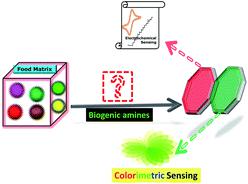当前位置:
X-MOL 学术
›
Anal. Methods
›
论文详情
Our official English website, www.x-mol.net, welcomes your
feedback! (Note: you will need to create a separate account there.)
A review on chemical and electrochemical methodologies for the sensing of biogenic amines.
Analytical Methods ( IF 2.7 ) Pub Date : 2020-06-10 , DOI: 10.1039/d0ay00358a Sanjeev Kumar Kannan 1 , Bebin Ambrose 2 , Sudalaimuthu Sudalaimani 1 , Manickam Pandiaraj 3 , Krishnan Giribabu 3 , Murugavel Kathiresan 2
Analytical Methods ( IF 2.7 ) Pub Date : 2020-06-10 , DOI: 10.1039/d0ay00358a Sanjeev Kumar Kannan 1 , Bebin Ambrose 2 , Sudalaimuthu Sudalaimani 1 , Manickam Pandiaraj 3 , Krishnan Giribabu 3 , Murugavel Kathiresan 2
Affiliation

|
Biogenic amines (BA) are biomolecules of low molecular weight with organic basic functionalities (amine group) that are formed by the microbial decarboxylation of amino acids of fermented food/beverages. Hence BAs are an important indicator in estimating the freshness and quality of meat, seafood, and industrial food products with high protein content. The reaction of BAs with nitrites available in certain meat products forms nitrosoamine, a carcinogenic compound. Hence BAs are in general considered to be a food hazard and monitoring the level of BAs in food samples becomes crucial as their high concentrations may lead to health problems. This review offers an overview of the available chemical and electrochemical methods that are typically used for the sensing of BAs in food samples. Certain compounds are known to selectively interact with BAs via chemical or non-covalent interactions and these interactions are often accompanied by fluorescence or visible color changes (sometimes visual detection) that could be monitored/assessed using a fluorescence spectrophotometer or UV-vis spectrophotometer (colorimetric methods). The colorimetric methods are limited by sensitivity and selectivity as they are based on straight-forward chemical reactions. In the case of electrochemical sensing of BAs, mediators are often used which undergo oxidation/reduction to produce intermediates that could interact with BAs accompanied by changes in their electrochemical potential. Overall, this review summarizes the available chemical and electrochemical strategies towards the sensing of BAs with a discussion on further prospects.
中文翻译:

化学和电化学方法学上的生物胺的综述。
生物胺(BA)是具有有机基本功能(胺基)的低分子量生物分子,是通过发酵食品/饮料氨基酸的微生物脱羧作用形成的。因此,BA是评估肉类,海鲜和高蛋白含量工业食品的新鲜度和质量的重要指标。BA与某些肉制品中可用的亚硝酸盐反应形成亚硝基胺,这是一种致癌化合物。因此,一般将BAs视为一种食物危害,监测食品样品中BAs的含量就变得至关重要,因为它们的高浓度可能导致健康问题。这篇综述概述了可用的化学和电化学方法,这些方法通常用于检测食品样品中的BA。已知某些化合物可与BA选择性相互作用通过化学或非共价相互作用,这些相互作用通常伴有荧光或可见的颜色变化(有时是视觉检测),可以使用荧光分光光度计或紫外可见分光光度计(比色法)进行监测/评估。比色法基于简单的化学反应,因此受到灵敏度和选择性的限制。在对BAs进行电化学检测的情况下,通常使用介体,该介体会进行氧化/还原以生成可与BAs相互作用并伴有电化学势变化的中间体。总的来说,本综述总结了可用于BA感测的化学和电化学策略,并讨论了进一步的前景。
更新日期:2020-07-16
中文翻译:

化学和电化学方法学上的生物胺的综述。
生物胺(BA)是具有有机基本功能(胺基)的低分子量生物分子,是通过发酵食品/饮料氨基酸的微生物脱羧作用形成的。因此,BA是评估肉类,海鲜和高蛋白含量工业食品的新鲜度和质量的重要指标。BA与某些肉制品中可用的亚硝酸盐反应形成亚硝基胺,这是一种致癌化合物。因此,一般将BAs视为一种食物危害,监测食品样品中BAs的含量就变得至关重要,因为它们的高浓度可能导致健康问题。这篇综述概述了可用的化学和电化学方法,这些方法通常用于检测食品样品中的BA。已知某些化合物可与BA选择性相互作用通过化学或非共价相互作用,这些相互作用通常伴有荧光或可见的颜色变化(有时是视觉检测),可以使用荧光分光光度计或紫外可见分光光度计(比色法)进行监测/评估。比色法基于简单的化学反应,因此受到灵敏度和选择性的限制。在对BAs进行电化学检测的情况下,通常使用介体,该介体会进行氧化/还原以生成可与BAs相互作用并伴有电化学势变化的中间体。总的来说,本综述总结了可用于BA感测的化学和电化学策略,并讨论了进一步的前景。









































 京公网安备 11010802027423号
京公网安备 11010802027423号